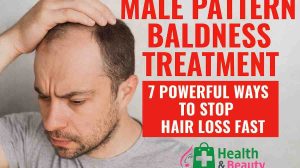On a quiet Monday morning in Chicago, David stared at the sink in disbelief. Another handful of hair. It wasn’t the first time, and he knew it wouldn’t be the last. At just 32, his thick black mane was slowly giving way to a receding hairline—a reality that statistics show will eventually affect most men worldwide. But what if there was a way to slow down, even stop, this relentless march of time? What if the solution wasn’t just in expensive clinics but in science-backed habits and treatments anyone could access?
This is how to prevent hair loss in men—with real data, actionable strategies, and the latest breakthroughs you can trust.
Understanding Why Hair Loss Happens in Men
The leading cause of hair thinning in men is androgenetic alopecia (AGA), also called male pattern baldness. Studies reveal that up to 50% of men over 50 face this condition, with the risk climbing to 80% by age 80. The culprit? A hormone called dihydrotestosterone (DHT), which shrinks hair follicles over time, making each strand thinner until it eventually stops growing.
While genetics play a major role, lifestyle factors, diet, and even stress can accelerate hair loss. That’s why prevention isn’t about one magic solution—it’s a strategy combining science, consistency, and healthy habits.
How to Prevent Hair Loss in Men
1. Start Early with Proven Medical Treatments
Finasteride: The Game-Changer
Clinical research shows that finasteride 1 mg daily can stop hair loss in up to 90% of men and even regrow hair in 65% when used for a year or more. By blocking DHT, it targets the root cause of male pattern baldness.
Men in studies taking finasteride for five years were far less likely to lose hair compared to those on placebo—35% vs. 100% continued hair loss. That’s a dramatic difference you can’t ignore.
Minoxidil: The Daily Booster
Applied directly to the scalp, minoxidil 5% solution increases blood flow to hair follicles. Research shows it can trigger visible regrowth within 8–12 weeks, with about 70% improvement compared to placebo groups.
Pro tip: For the best results, many doctors recommend combining finasteride and minoxidil—a one-two punch proven to outperform either treatment alone.
According to the American Academy of Dermatology, early intervention remains the most effective way to prevent significant hair loss in men. Their expert-reviewed resources highlight evidence-based treatments, lifestyle changes, and cutting-edge options for men experiencing thinning hair. Reading their guide can help you make informed decisions and avoid common mistakes that worsen hair loss over time.
2. Harness New Technologies Like Laser Therapy
Low-Level Laser Therapy (LLLT) devices—yes, those futuristic helmets and combs—aren’t gimmicks. Meta-analyses reveal that consistent use (about 15 minutes a day) can increase hair density by 10–20% in just a few months.
These red-light wavelengths energize follicles at the cellular level, improving growth cycles without pain or downtime. Think of it as physical therapy for your scalp.
3. Boost Results with PRP and Microneedling
Platelet-Rich Plasma (PRP) therapy, where your own platelets are injected into thinning areas, has gained traction in dermatology clinics. A 2024 meta-analysis showed PRP combined with minoxidil significantly increased hair count and thickness compared to minoxidil alone.
Similarly, microneedling—tiny controlled injuries to the scalp—stimulates collagen production and improves topical treatment absorption. Together, they create a fertile environment for hair regrowth.
If you’re focusing on what treatments work best, Male Pattern Baldness Treatment: 7 Powerful Ways to Stop Hair Loss Fast complements this article by covering both conventional and holistic methods to halt thinning and restore confidence.
4. Address Lifestyle and Nutritional Factors
Even the best treatments struggle if your daily habits sabotage your progress. Research links smoking to accelerated hair loss, while chronic stress triggers a shedding condition called telogen effluvium, affecting up to 20% of men after major illness or psychological strain.
Nutritional deficiencies also matter. Low vitamin D and iron levels often correlate with hair thinning. Getting tested and correcting deficiencies can support healthier growth from within.
Actionable tips:
- Quit smoking to improve scalp circulation.
- Manage stress with meditation, exercise, or therapy.
- Include protein, omega-3s, and vitamins A, D, E, and B-complex in your diet.
5. Consider Surgical Solutions When Necessary
When hair loss has advanced, hair transplantation offers a permanent solution. Global data from the International Society of Hair Restoration Surgery reported over 700,000 procedures worldwide in 2021, reflecting growing confidence in modern techniques like FUE (Follicular Unit Extraction).
However, doctors emphasize the importance of continuing finasteride or minoxidil post-surgery to protect remaining natural hair.
The Emotional Side of Hair Loss
Beyond vanity, hair loss affects confidence and mental well-being. Studies link male pattern baldness to higher rates of anxiety and social withdrawal. That’s why prevention isn’t just cosmetic—it’s about self-esteem, relationships, and quality of life.
Taking control early sends a powerful message: you care about your health, appearance, and future.
A 6-Month Prevention Roadmap
- Month 1: Consult a dermatologist for diagnosis and baseline photos.
- Month 2–3: Start finasteride and/or minoxidil as prescribed.
- Month 4: Add LLLT or microneedling if desired.
- Month 5: Check vitamin D and iron levels; adjust diet.
- Month 6: Reassess progress with your doctor—expect thicker, fuller hair if compliant.
Consistency is key. Skipping treatments or stopping too soon reverses gains.
Final Thoughts
The science is clear: how to prevent hair loss in men isn’t a mystery anymore. Early intervention with finasteride, minoxidil, laser therapy, and lifestyle changes can stop or even reverse thinning for most men. Add PRP or surgery when needed, and you have a comprehensive plan backed by real evidence.
Your hairline doesn’t have to be a ticking time bomb. Start now, stay consistent, and give science a chance to work for you.







